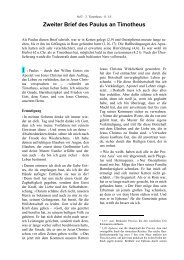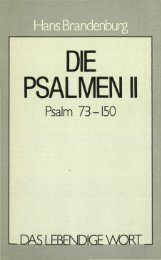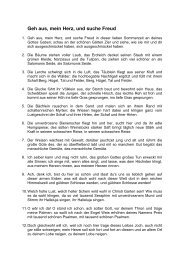Create successful ePaper yourself
Turn your PDF publications into a flip-book with our unique Google optimized e-Paper software.
total anatomy and physiology of a human being,<br />
but also our numerous predispositions and gifts.<br />
For example, musical ability, aggressiveness, or<br />
language aptitude. Are the non-material characteristics<br />
of people, for example, the ability to<br />
love, or experience joy, in fact reducible to being<br />
described by a nucleotide sequence? Here we still<br />
face major scientific mysteries.<br />
Information processing: <strong>Our</strong> 30,000 genes provide<br />
exact instructions to each cell for manufacturing<br />
everything required for it to carry out the<br />
role for which it is programmed; whether hormones,<br />
enzymes, mucus, sebum, the weapons of<br />
the immune system, or the impulses in the nerve<br />
cells of the central nervous system.<br />
One might well ask at this point: How is this<br />
information decoded, and how are these abstract<br />
“words” translated into concrete protein molecules?<br />
This never-ending process takes place<br />
inside an unimaginably small space, namely<br />
within the cells, each measuring only a few hundredths<br />
of a millimetre. Special protein molecules<br />
locate a particular piece of information – a gene –<br />
copy it, and prepare a messenger, a chemical relative<br />
of DNA called messenger-RNA. This mRNA<br />
then travels from the control centre in the nucleus<br />
out into the cytoplasm, to the ribosomes.<br />
These small granular bodies are where protein<br />
synthesis takes place. When these RNA messengers<br />
arrive here, they specify the sequence in<br />
which the 20 types of amino acids, the building<br />
blocks of all proteins, are to be assembled. Protein<br />
molecules are constructed here “block by<br />
block”, just as a house is built brick by brick; they<br />
are subsequently dispatched to carry out their<br />
various vital functions.<br />
The next important step, namely the formation of<br />
specific structures like cells and <strong>organs</strong> from<br />
these protein molecules, is very complex, and is<br />
not yet fully understood. But we do know that it<br />
is somehow encoded in our genes * , and it largely<br />
determines what we are. <strong>Our</strong> genes ensure that<br />
we become human beings rather than animals.<br />
<strong>Our</strong> gender, the colour of our eyes, skin and hair,<br />
and to a great extent our size, are all determined<br />
by our personal genome. It sets parameters for<br />
our intelligence and, to a large extent, determines<br />
our never-to-be-repeated unique personality. All<br />
these patterns are set at the precise moment in<br />
which the male chromosomes in a sperm cell<br />
meet up with those of a female egg cell (ovum).<br />
The moment of fertilisation truly is the starting<br />
point of our life.<br />
A comparison: Each of our approximately 100<br />
million million (10 14 ) cells has the following main<br />
components: a cell membrane, many pores and<br />
channels in this membrane, many mitochondria<br />
for regulating the flow of energy, many ribosomes<br />
which translate genetic information into<br />
proteins, and a nucleus containing the genetic<br />
information in the form of DNA.<br />
Nowadays many people are familiar with the<br />
parts of a personal computer (PC), like hard disk,<br />
read/write head, interface, and network card. To<br />
explain the performance and complex functioning<br />
of a biological cell, Zoltán Takács, a biophysicist,<br />
compared the processing and storage of information<br />
in a cell with what happens inside a<br />
computer. If a cell in simplified form is regarded<br />
as a computer, we have the following analogies:<br />
– The cell membrane would be the computer<br />
housing, but it is only 10 nanometres thick<br />
(= one hundred thousandth of a millimetre).<br />
– The pores and channels are the interfaces.<br />
– The mitochondria comprise 800 network<br />
cards.<br />
– A ribosome would be a central processing<br />
unit (CPU), but a biological cell has more than<br />
six million CPUs.<br />
– The nucleus would correspond to a hard drive.<br />
There would then be 23 different hard disks<br />
(= chromosomes), each of which has its own<br />
backup disk. The storage capacities of these<br />
23 disks add up to about 1 Gigabyte. Biological<br />
“hard disks” are actually not hard, but can perhaps<br />
be regarded more like ”floppy disks”; the<br />
46 strands of DNA do not rotate around<br />
a fixed spindle, but occur as loose clusters in<br />
the nucleus.<br />
– The diameter of this biological computer is<br />
about 20 micrometres (= two hundredths of<br />
a millimetre).<br />
77
















